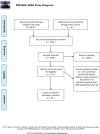A Systematic Review of Predictions of Survival in Palliative Care: How Accurate Are Clinicians and Who Are the Experts?
- PMID: 27560380
- PMCID: PMC4999179
- DOI: 10.1371/journal.pone.0161407
A Systematic Review of Predictions of Survival in Palliative Care: How Accurate Are Clinicians and Who Are the Experts?
Abstract
Background: Prognostic accuracy in palliative care is valued by patients, carers, and healthcare professionals. Previous reviews suggest clinicians are inaccurate at survival estimates, but have only reported the accuracy of estimates on patients with a cancer diagnosis.
Objectives: To examine the accuracy of clinicians' estimates of survival and to determine if any clinical profession is better at doing so than another.
Data sources: MEDLINE, Embase, CINAHL, and the Cochrane Database of Systematic Reviews and Trials. All databases were searched from the start of the database up to June 2015. Reference lists of eligible articles were also checked.
Inclusion criteria: patients over 18, palliative population and setting, quantifiable estimate based on real patients, full publication written in English.
Exclusion criteria: if the estimate was following an intervention, such as surgery, or the patient was artificially ventilated or in intensive care.
Study appraisal and synthesis methods: A quality assessment was completed with the QUIPS tool. Data on the reported accuracy of estimates and information about the clinicians were extracted. Studies were grouped by type of estimate: categorical (the clinician had a predetermined list of outcomes to choose from), continuous (open-ended estimate), or probabilistic (likelihood of surviving a particular time frame).
Results: 4,642 records were identified; 42 studies fully met the review criteria. Wide variation was shown with categorical estimates (range 23% to 78%) and continuous estimates ranged between an underestimate of 86 days to an overestimate of 93 days. The four papers which used probabilistic estimates tended to show greater accuracy (c-statistics of 0.74-0.78). Information available about the clinicians providing the estimates was limited. Overall, there was no clear "expert" subgroup of clinicians identified.
Limitations: High heterogeneity limited the analyses possible and prevented an overall accuracy being reported. Data were extracted using a standardised tool, by one reviewer, which could have introduced bias. Devising search terms for prognostic studies is challenging. Every attempt was made to devise search terms that were sufficiently sensitive to detect all prognostic studies; however, it remains possible that some studies were not identified.
Conclusion: Studies of prognostic accuracy in palliative care are heterogeneous, but the evidence suggests that clinicians' predictions are frequently inaccurate. No sub-group of clinicians was consistently shown to be more accurate than any other.
Implications of key findings: Further research is needed to understand how clinical predictions are formulated and how their accuracy can be improved.
Conflict of interest statement
The authors have declared that no competing interests exist.
Figures



References
-
- Degner LF, Kristjanson LJ, Bowman D, Sloan JA, Carriere K, O'Neil J, et al. Information needs and decisional preferences in women with breast cancer. Jama. 1997;277(18):1485–92. - PubMed
-
- Steinhauser KE, Christakis NA, Clipp EC, McNeilly M, Grambow S, Parker J, et al. Preparing for the end of life: preferences of patients, families, physicians, and other care providers. Journal of Pain and Symptom Management. 2001;22(3):727–37. - PubMed
-
- Kutner JS, Steiner JF, Corbett KK, Jahnigen DW, Barton PL. Information needs in terminal illness. Social science & medicine. 1999;48(10):1341–52. - PubMed
Publication types
MeSH terms
Grants and funding
LinkOut - more resources
Full Text Sources
Other Literature Sources
Medical
Research Materials
Miscellaneous

